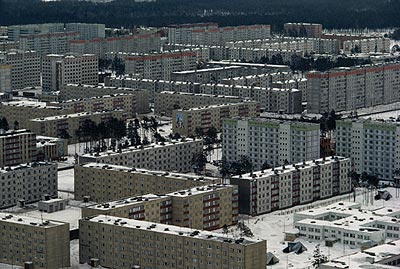Controversy about life at Chernobyl
After 20 years of nuclear disaster, the level of radiation at Chernobyl caused insects to stay away from the area. However, some scientists believe that animals have evolved to adapt to the pollution environment.
According to a recent study published in Biology Letters, in areas that are limited around Chernobyl, there are still signs of a decline in the organism population due to radioactivity.
The team found that most common insects such as bees, butterflies, grasshoppers, dragonflies and spiders are away from areas that were once contaminated.

Since 1986, a radioactive winter has covered the region of Pripyat, Ukraine.
This research has contributed by many names in biology industry such as Professor Timothy Mousseau, University of South Carolina or Dr. Anders Moller, University of Paris-Sud. Previously, they also had a complete study of the negative effects of low activity radioactivity on bird populations here.
Professor Mousseau said: 'We will continue to expand this topic to study the effects of radiation on both insects, animals and plants' . He studied for decades in contaminated areas around the former Chernobyl accident. This area has been inhabited by people since the accident.
The research method used by Professor Mousseau's group is called 'standard ecological engineering'. The researchers counted the number of insects and spider webs on a hypothetical transect in the contaminated area and measured the radioactivity to find out how radiation affects the organism.
Research results show that the number of living individuals find a strong decrease in activity areas. Based on that, Professor Mousseau concluded, some insects are very sensitive to radioactive contamination.
However, the report has met with opposition from local researchers. "The absence of human activity will be the driving force for the insect population to increase, not decrease ," said Professor Sergyi Gashchak, who works at the Chornobyl Research Center, Ukraine.

Life still exists in radioactive areas.
He affirmed: 'Wildlife is mastering at Chernobyl due to no human. Their resistance and development have evolved to survive under deadly radiation conditions here. "
According to a study by Professor Gashchak, when an accident occurred, the activity of radioactivity here exceeded the tolerance of living organisms, but after 10 years, it was reduced thousands of times.
However, in theory, the main radioactive substances like Radon and thorium have a half-life of about 15 to 20 years, while Cesi (137 isotopes) or Strontium isotope 90 is 30 years. Therefore, after 23 years, the amount of radiation only decreased by 1.5 to 2 times. In theory, the process of reducing natural radioactive contamination in Chernobyl takes between 2,000 and 3,000 years.
Chernobyl atomic disaster occurred on April 26, 1986 when the Chernobyl nuclear power plant in Pripyat, Ukraine exploded. This is considered the most serious accident in the history of nuclear energy. Due to the absence of a retaining wall, the cloud of radioactive dust from the factory spread to many parts of the western part of the Soviet Union, Eastern and Western Europe, Scandinavia, the United Kingdom, and the eastern United States. Large areas of Ukraine, Belarus and Russia are seriously polluted, leading to evacuation and resettlement for more than 336,000 people.
- Chernobyl is a human disaster, but good news for animals here
- New discovery of the Chernobyl nuclear disaster effect
- Chernobyl and the magic of nature
- What will happen if you come to live at Chernobyl 'Dead Land' now?
- Giant catfish over 2m long due to Chernobyl radiation?
- I was burned by a contaminated mosquito at Chernobyl
- Ukraine unloaded the 'concrete coffin' that was about to collapse at the Chernobyl factory
- Europe at risk of radiation radiation
- Wild animals proliferate where ever a nuclear disaster occurred
- Chernobyl: The 30-year exotic forest doesn't decompose
- The first bottle of vodka in the world produced by Chernobyl cereals
- Sequelae of nuclear leakage on Chernobyl trees
 Why do potatoes have eyes?
Why do potatoes have eyes? 'Tragedy' the world's largest carnivorous life: Death becomes ... public toilet
'Tragedy' the world's largest carnivorous life: Death becomes ... public toilet Tomatoes were once considered 'poisonous' for 200 years
Tomatoes were once considered 'poisonous' for 200 years Detecting microscopic parasites on human face
Detecting microscopic parasites on human face